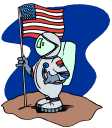By Laura G. Smith

|
Race to the Moon
By Laura G. Smith |

|
 1 On July 20, 1969, millions of curious viewers hovered around their television sets to observe history in the making as astronaut Neil Armstrong stepped onto the moon's rocky surface and uttered the famous words-"That's one small step for man, one giant leap for mankind." It was a moment of triumph as America celebrated the first manned lunar landing.
1 On July 20, 1969, millions of curious viewers hovered around their television sets to observe history in the making as astronaut Neil Armstrong stepped onto the moon's rocky surface and uttered the famous words-"That's one small step for man, one giant leap for mankind." It was a moment of triumph as America celebrated the first manned lunar landing. |
Create Weekly Reading Books
Prepare for an entire week at once! |
| Leave your feedback on Race to the Moon (use this link if you found an error in the story) |